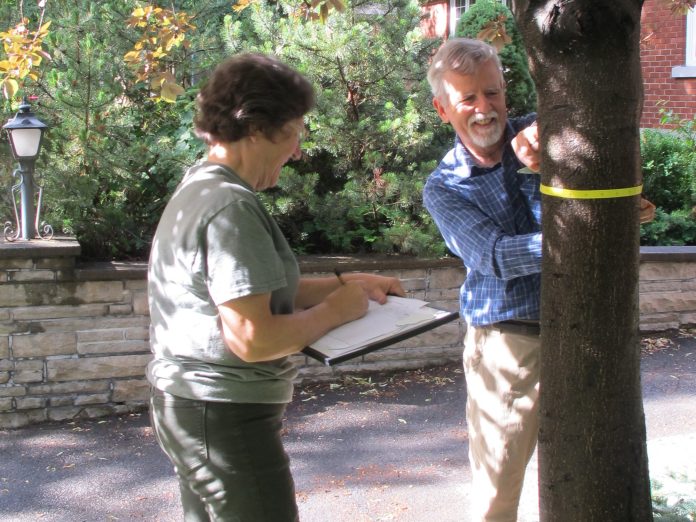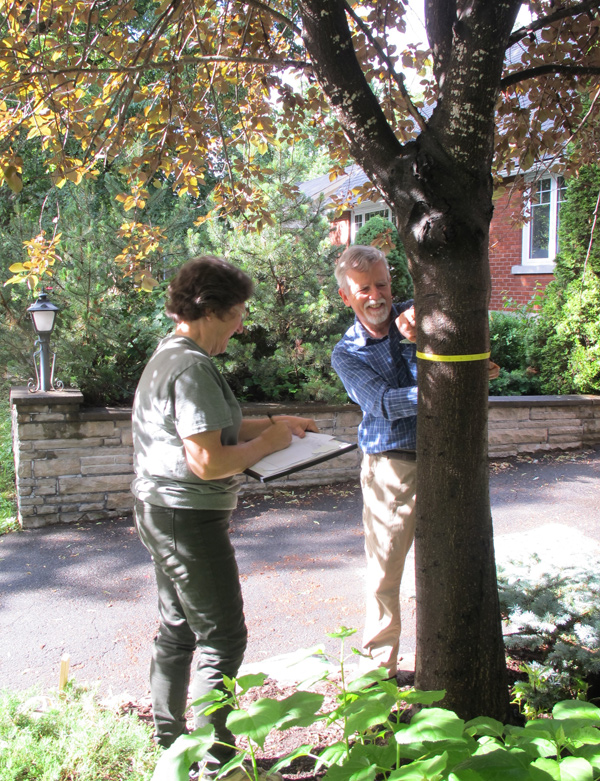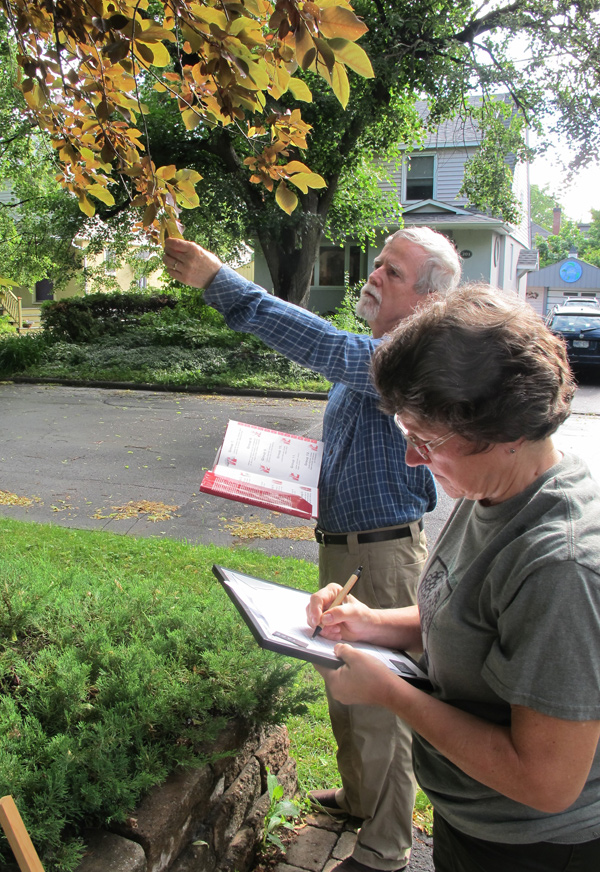By Andrea Prazmowski –
Daniel Buckles and Catherine Shearer are getting better acquainted with their neighbourhood, one tree at a time. You might see them and other volunteers out on the streets, peering at the leaves of trees, inspecting their branches, wrapping measuring tape around their trunks, and taking lots of notes.
The project is Neighbourwoods in Champlain Park. This is the second summer the volunteers are knocking on doors and asking permission to take a close look at the trees on people’s property. It will take several years to cover the 20 blocks of their neighbourhood, but it’s already showing results.
“There was one home where there was a spruce tree on the property. The homeowner had planted it as a child and had an attachment to the tree and had noticed it wasn’t doing well,” Daniel recalls. “When we mapped it, we realized the tree was planted on a slope and water was running off and the soil was drying out quickly.” The person took action to bring the tree back to health, reducing the slope and adding new soil.
That’s the kind of response Daniel hoped for when he brought the project to the neighbourhood last year. While some people have a special affection for the trees in their yards, Daniel says he was somebody who used to take trees for granted.
“I didn’t pay much attention to them,” he says. “It was just kind of a green background.” That changed about seven years ago, when numerous infill projects came to the area and big trees were cut down to make way for big homes.
“The experience of trying to protect individual trees led me to pay more attention to all the trees and to appreciate them more,” he says.
“Urban trees provide numerous benefits,” he adds. They capture storm water and reduce flooding, provide shade and reduce the need for air conditioning, and clean the air of pollutants.
The City manages more than 150,000 trees along Ottawa’s urban streets, and tens of thousands more in parks and open spaces. But 40% of the urban area is private property and there are a significant number of trees on those properties. It’s extremely difficult for the City to map these trees, says Catherine. And that’s where the volunteers can be invaluable. They’ve been trained to identify the tree species, and assess the size and health of each tree.
Neighbourwoods is a tree inventory protocol developed by two University of Toronto professors to assist communities in collecting the tree information they need to plan and manage their urban forest. It’s been adopted by a number of communities across Ontario.
Catherine likes that Neighbourwoods “was designed to be used by people who aren’t professional foresters but there is the rigour of a professional survey.” She hopes the idea spreads to other neighbourhoods in Ottawa. “I would like to see the City appreciate the effort and input that the average citizen can bring to this,” she says.
The data will help the City and community groups plan ways to take care of the trees, replace them when they die, and identify places to plant new trees and what kind of trees to plant, in order to have a diverse and healthy urban forest.
The first step though, is paying attention, says Daniel. “To protect the trees, you have to notice the trees.”
[Readers who are interested in this topic might enjoy this student documentary about The Champlain Oaks Project featuring Daniel Buckles.]
Other Kitchissippi tree initiatives
- Volunteer Gardeners of Clare Gardens Park are creating a play about trees in their neighbourhood and will perform it on September 12. It’s part of an Odyssey Theatre community project called Spreading Roots.
- Big Trees of Kitchissippi is a collaboration among seven community associations and two citizens’ groups, working to protect big trees in backyards and on streets in Kitchissippi. Their new website is at bigtreeskitch.wixsite.com/trees.
- The Champlain Oaks Project: A volunteer group of neighbours dedicated to celebrating, preserving, and restoring the historic Oak forest in Ottawa’s West end. For info, go to champlainoaks.com.


